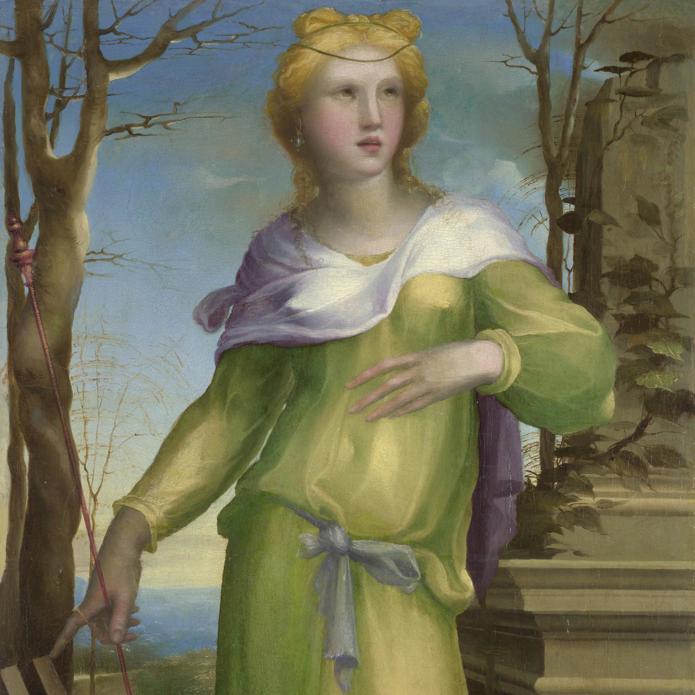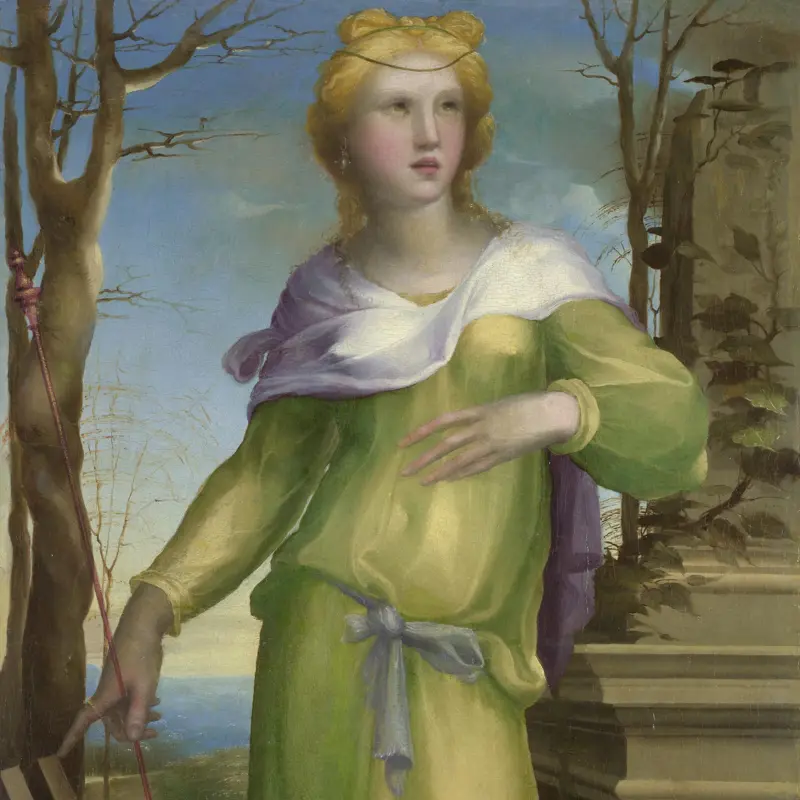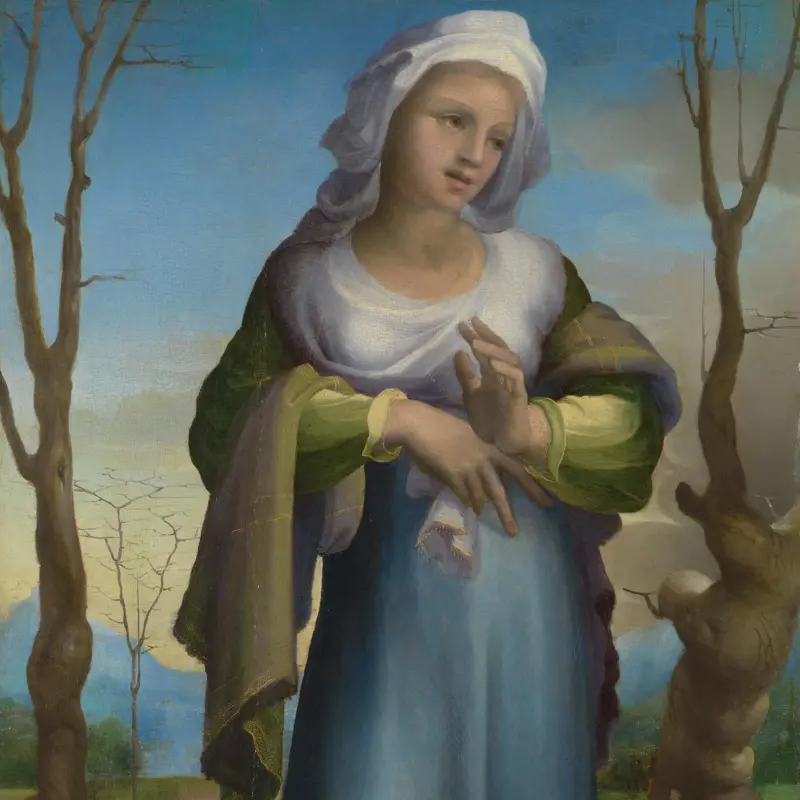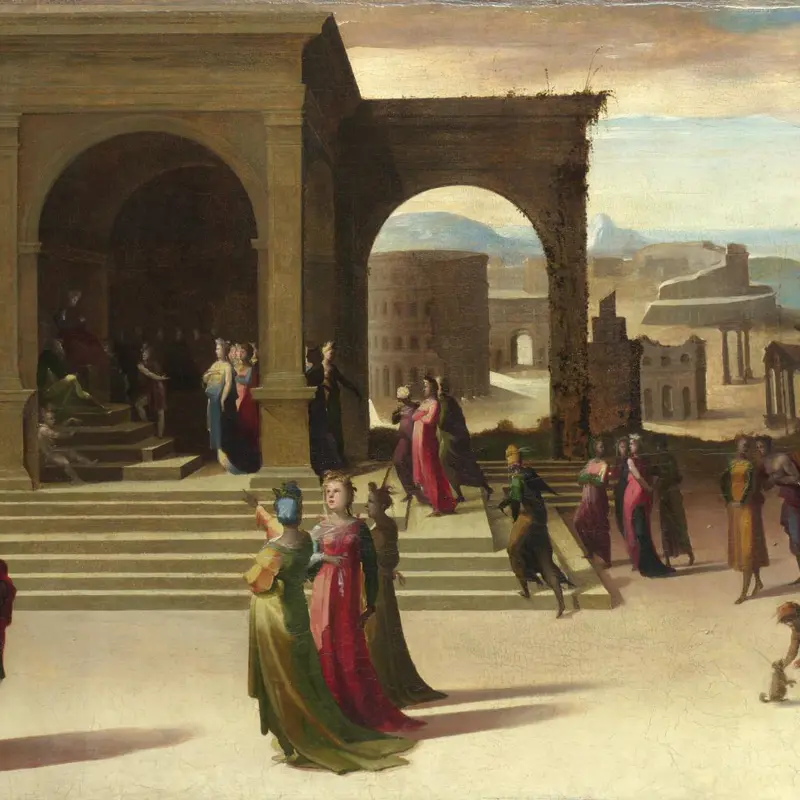Domenico Beccafumi, 'Tanaquil', about 1519
About the work
Overview
This panel is part of a series Beccafumi painted for the bedchamber of Francesco di Camillo Petrucci (b.1489), a wealthy merchant and landowner who was nephew of the ruler of the republic of Siena. The decorations were probably made to coincide with Francesco’s marriage to Caterina di Niccolò Mandoli Piccolomini in 1512 and were completed in 1519. Three of the six surviving panels from the series show Roman heroines – Tanaquil, Cornelia and Marcia – and they probably decorated the back of a bench seat.
Tanaquil persuaded her husband Lucumo to emigrate from Tarquinii to Rome, where he was elected king with the title Tarquinius Priscus. After his assassination she secured the political succession for their slave, Servius Tullius. The paintings of the three heroines each contain a Latin couplet in gilt lettering, most likely composed by the scholar who devised the decorative scheme for the bedchamber.
Key facts
Details
- Full title
- Tanaquil
- Artist
- Domenico Beccafumi
- Artist dates
- 1484 - 1551
- Part of the series
- Classical Heroines from a Sienese Bedchamber
- Date made
- About 1519
- Medium and support
- Oil, originally on wood (probably poplar), transferred to canvas
- Dimensions
- 92.1 × 53.3 cm
- Inscription summary
- Inscribed
- Acquisition credit
- Acquired by application of the 1956 Finance Act, 1965
- Inventory number
- NG6368
- Location
- Room 6
- Collection
- Main Collection
- Previous owners
- Frame
- 19th-century English Frame
Provenance
Additional information
Text extracted from the ‘Provenance’ section of the catalogue entry in Cecil Gould, ‘National Gallery Catalogues: The Sixteenth Century Italian Schools’, London 1987; for further information, see the full catalogue entry.
Bibliography
-
1864A Catalogue of the Pictures, Works of Art, Etc., at Northwick Park, London 1864
-
1878G. Vasari, Le vite de'più eccellenti pittori, scultori ed architettori: Con nuove annotazioni e commenti di Gaetano Milanesi, ed. G. Milanesi, 8 vols, Florence 1878
-
1901A. Venturi, Storia dell'arte italiana, 11 vols, Milan 1901
-
1921T. Borenius, Catalogue of the Collection of Pictures at Northwick Park, London 1921
-
1940J. Pope-Hennessy, 'Beccafumi in the Victoria and Albert Museum', The Burlington Magazine, LXXVI/445, 1940, pp. 110-23
-
1966On View: The Guide to Museum and Gallery Acquisitions in Great Britain, London 1966
-
1967The National Gallery, The National Gallery: January 1965 - December 1966, London 1967
-
1967D. Sanminiatelli, Domenico Beccafumi, Milan 1967
-
1967P. Hendy, 'IV Director's Report: 2. Acquisitions 1965-66', The National Gallery Annual Report: January 1965 - December 1966, 1967, pp. 15-26
-
1975C. Gould, Delaroche and Gautier: Gautier's Views on the 'Execution of Lady Jane Grey' and on other Compositions by Delaroche, London 1975
-
1977G. Briganti, L'opera completa del Beccafumi, Milan 1977
-
1979V. Tátrai, 'Il Maestro della storia di Griselda e una famiglia senese di mecenati dimenticata', Acta historiae artium, XXV/1-2, 1979, pp. 27-66
-
1981National Gallery, 'Anniversary Artist: Beccafumi', National Gallery News, 1981
-
1982Christie, Manson and Woods, Christie's Sales to the Nation 1956-1982, London 1982
-
1987Gould, Cecil, National Gallery Catalogues: The Sixteenth Century Italian Schools, London 1987
-
1990F.S. Santoro and G. Agosti, Domenico Beccafumi e il suo tempo, (exh. cat. Pinacoteca Nazionale di Siena, Palazzo Bindi Sergardi, 16 June - 4 November 1990), Milan 1990
-
1998P. Torriti, Beccafumi, Milan 1998
-
1999P. Dubus, Domenico Beccafumi, Paris 1999
-
2001
C. Baker and T. Henry, The National Gallery: Complete Illustrated Catalogue, London 2001
-
2002O. Bradbury and N. Penny, 'The Picture Collecting of Lord Northwick: Part II' The Burlington Magazine, CXLIV/1195, October 2002, pp. 606-17
-
2003M. Caciorgna and R. Guerrini, La virtù figurata: Eroi ed eroine dell'antichità classica nell'arte senese tra Medioevo e Rinascimento, Siena: Fondazione Monte dei Paschi di Siena 2003
-
2007L. Syson et al., Renaissance Siena: Art for a City (exh. cat. The National Gallery, 24 October 2007 - 13 January 2008), London 2007
-
2008C. Baskins, The Triumph of Marriage: Painted Cassoni of the Renaissance (exh. cat. Isabella Stewart Gardner Museum, 16 October 2008 - 18 January 2009; The John and Mable Ringling Museum of Art, 14 February - 17 May 2009), Boston 2008
About this record
If you know more about this work or have spotted an error, please contact us. Please note that exhibition histories are listed from 2009 onwards. Bibliographies may not be complete; more comprehensive information is available in the National Gallery Library.
Images
About the series: Classical Heroines from a Sienese Bedchamber

Overview
These two Roman heroines, Marcia and Tanaquil, are part of a series of painted panels that decorated the bedchamber of Francesco di Camillo Petrucci (b. 1489), a wealthy merchant and landowner who was nephew of Pandolfo Petrucci, ruler of the republic of Siena. Celebrating themes of love, fertility, and wifely and maternal virtue, the decorations were probably made to coincide with Francesco’s marriage to Caterina di Niccolò Mandoli Piccolomini in 1512 and completed in about 1519.
Six of the paintings still exist, though they are in different collections. Three show Roman heroines (the one not in the National Gallery depicts Cornelia) and two feature the Roman festivals of Lupercalia and Cerealia, which were associated with male fertility and female fecundity. A painting of Venus and Cupid probably decorated the bedhead. The paintings of the three heroines and Lupercalia each contain a Latin couplet in gilt lettering likely to have been devised by the scholar responsible for the decorative programme.



